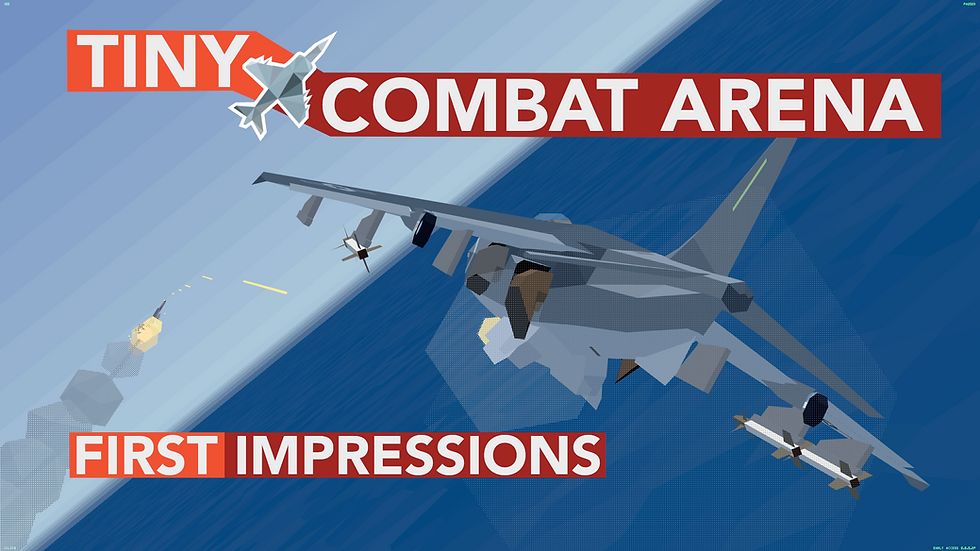First Impression: Nova Squadron (Steam Next Fest Alpha Demo 0.1.0)
- Aaron "Ribbon-Blue" Mendoza

- Feb 1, 2023
- 6 min read
Updated: Oct 23, 2023

Just a few days before the beginning of Steam Next Fest 2023 (February 6th to February 13th, 2023), fans of the flight game genre have been given early access to the first demo for Nova Squadron. As someone who continuously checks in on this online indie gaming festival, there are usually very few flight games available per event. Seeing six demos in one festival could be considered a "big turnout" for the genre. After just a few days with this demo, it's safe to say that the genre will be well represented this time around.
Nova Squadron has actually been in development since May 2020 by its developer Clara Gale. From its initial tweet that joked about planes "being complicated" to the release of alpha demo 0.1.0 on January 26th, 2023, Nova Squadron has covered a lot of ground in roughly over two years and eight months. After eagerly waiting for a chance to try it finally, I spent some quality time with the demo.
Introduction
For those that don't know, Nova Squadron is a still-in-development single-player arcade flight simulator. It utilizes a rougelite system as a part of its core gameplay. As players start new "Runs" (a.k.a. campaigns), their progress yields two types of currency that are used for temporary upgrades that reset after each Run is over or can be used for more permanent upgrades over time. The story so far takes place in the atmosphere of Jupiter in the year 2283. As a pilot of the overwhelmed Interplanetary Nations Defense Force, players lead Nova Squadron against a coalition of galactic nations and city-states attempting to invade Mars. Utilizing a map of Jupiter to show the order of battle between each side, Nova Squadron embarks on offensive and defensive missions to win the war. The enemies include frigate-class space warships, levitating military bases, and swarms of high-performance fighters.
Here are a few things that jumped out on the initial playthroughs:
User Interface (UI)
This is something I want to highlight briefly. Not flight related, but this game easily has one of the cleanest user interfaces I've seen in a while. Even for more complicated functions related to customization and upgrades, the UI remains consistent and smooth. The tactical map shown before and after each sortie is fantastic. It is simple enough to understand at a glance, with clearly shown directions indicating what friendly and enemy forces are doing—enough info to inform but not overwhelm players.
No Nonsense Tutorial
Nova Squadron starts with the player flat spinning out of a high-altitude battle, needing to perform a flight system and weapon system check before re-engaging in combat. What made this tutorial stick out was how no-nonsense it was regarding what controls players could and could not use as the tutorial moved on. If the next maneuver was a standard roll, then pitch turn, the developer made it so focusing on that maneuver was the only thing you could do. There was no question as to whether or not it was the correct maneuver. There was only one option! It sounds restrictive, but it made the tutorial more concise.
Flight Model and The Phoenix
Just hearing this setup, I fully expected the flight model to be "cracked." That is to say, nearly unmanageable. With aircraft responsiveness being so sensitive, keeping track of close-range dogfights and making small control inputs would be almost impossible. I was fully prepared to start setting axis curves to dampen control inputs.

I was completely wrong. The player-controlled fighter known as the Phoenix is not only easy to fly but is probably underperforming compared to expectations. That's not a complaint. The Phoenix can handle anything thrown at it from the beginning. Its speed, roll, pitch, and yaw rates are what you'd expect from the "starter" aircraft in a flight arcade game. The default controls are tuned enough to even allow for the precision firing of unguided ordinance.
Alongside its onboard laser cannons, it can equip primary and secondary weapons. These include proximity fused cannons, various types of laser cannons, two types of homing missiles, a tesla coil type weapon (a personal favorite), and other futuristic options. Its initial stats favor speed more than anything else, with mobility being the second highest stat. From the start, it doesn't have the ability to perform wild airshow-style maneuvers while flying at high Mach speeds. At lower speeds, its reaction control system can temporarily boost its pitch rate, but it's not enough to wildly boost its maneuverability.

However, the Phoenix's baseline performance being at this level further emphasizes all aspects of customization and upgrades possible in this game. Even the most minor performance change is noticeable, making any unlocked upgrade appreciated. After putting in some concentrated time to see how far I could improve the Phoenix, I found myself caring much more about every possible upgrade. It made me care more about what exactly I was trying to accomplish rather than haphazardly attaching parts just because they were available. I sincerely hope its baseline performance doesn't change much in the coming months or by the game's release in 2024. The way the Phoenix is presented in this game right now is a smart move.
Customizations and Upgrades
Nova Squadron has three layers of customization. At the squadron level, players can edit just about every aspect of their flight of five aircraft. The player can change the primary and secondary weapon systems per aircraft, change three layers of paint customization, and even the engine plume color. Players can customize the Nova Squadron to their preference in every mission if desired. While an option to apply a paint scheme to all aircraft in the flight would help reduce editing time and make it easier to coordinate liveries, there is little else a player could ask for. With a full-color palette available, this game is sure to have some eclectic screenshots in the near future.
During a Run players receive Credits (CR) and Renown points after each mission. It's important to know when to spend and when to save for more successful future runs. Upgrades that are purchased with Credits are only in effect during the active run. These minor performance upgrades reset at the start of each run. So hoarding credits long-term doesn't have much value. New parts are unlocked after each mission in a Run, but they, too, are reset when a Run is over.

Renown points are used for more permanent upgrades that carry over to all new Runs once they are bought and equipped to an aircraft. Parts unlocked with Renown points remain unlocked, giving players an immediate edge early in the game. General upgrades to aircraft speed, mobility, defense, and internal cannon are done with the Research Point option. These effectively act as building blocks for accessing more advanced builds faster in later playthroughs.

Mission Restrictions
In the demo, there are four types of missions available. They include dogfights, interception missions, and ground attack missions. Well, "ground". The focus in those missions is destroying bases levitating in the atmosphere. I mean, it's Jupiter. There's no land; what do you want? I liked that some of the mission restrictions varied between either destroying enough enemies to exceed a certain amount of points or destroying specific targets while still leaving time for players to rack up extra credits by shooting down other targets at will.
Planned Updates to the Demo
According to the demo's announcement post on Steam, it will receive updates over the next few months. These include new mission types, new enemies, a new ground attack focused aircraft for players to fly, and other features. With the demo being available long-term, it's a good chance for players to see how their developer will continue refining the game as a whole while updating a demo new and old players can refer to at any time. Recently, I've noticed a few still-in-development flight games taking this same path, and you can't help but appreciate how available these developers make themselves for suggestions, interactions, and edits directly from players. It's commendable.

Nova Squadron alpha demo 0.1.0 is a strong, positive step forward for this indie game. I think it will perform well at Steam Next Fest, even with players brand new to the franchise, because of how approachable, easy to understand, and how rewarding time put into the game can be when the result is a custom aircraft tailored for their own use. I'll be sure to let everyone know when my peak high-speed interceptor build is complete! Be sure to check out the demo for yourselves during next week's Steam Next Fest.
About the Writer
Aaron "Ribbon-Blue" Mendoza

Co-founder of Skyward Flight Media. After founding Electrosphere.info, the first English Ace Combat database, he has been involved in creating flight game-related websites, communities, and events since 2005. He explores past and present flight games and simulators with his extensive collection of game consoles and computers. Read Staff Profile.

















































.png)